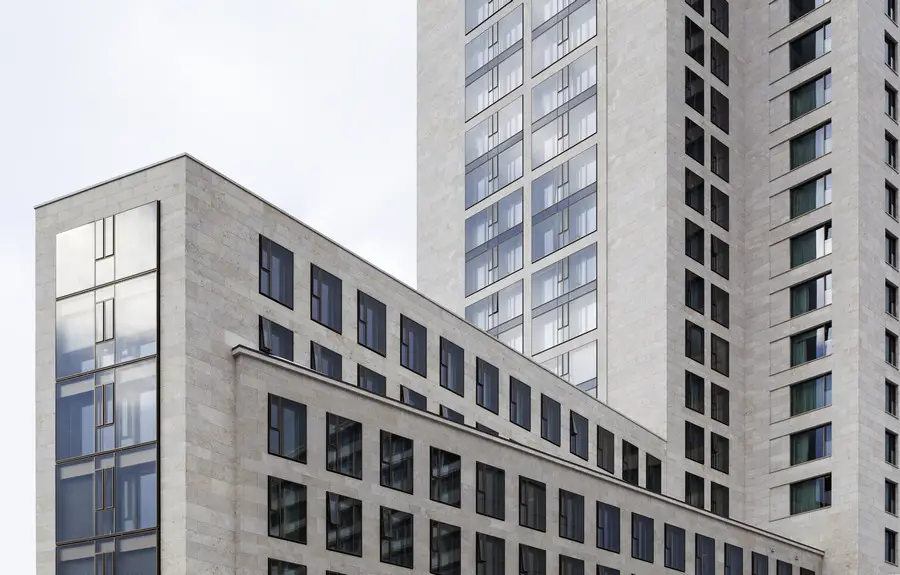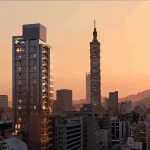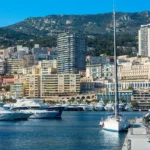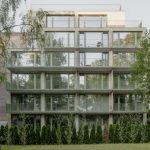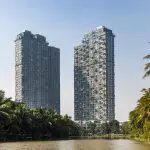Zoofenster Berlin Building Photos, German Tower Design, Christoph Mäckler Architecture Images
Zoofenster Berlin Building
Tower Architecture, Germany design by Christoph Mäckler architect.
The Zoofenster in Berlin by Christoph Mäckler
Design: Christoph Mäckler
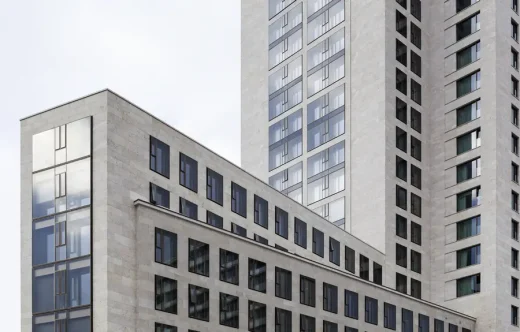
Prof. Christoph Mäckler Architekten / Photographer: Hans-Georg Esch
3 Sep 2013
Zoofenster Berlin
At just under 119 m, the Zoofenster is one of Berlin’s tallest buildings. And yet it is in no way a typical high-rise block. Instead, it is a complex, tiered structure that responds to its urban environment in a number of ways. It consists of a 22-storey block and 32-storey tower that rise above a lower block that occupies the entire plot and reflects the height and lines of the neighbouring six-storey buildings.
This medium-rise block creates clearly structured urban spaces and carries these as far as Breitscheidplatz. And facing Hardenbergstrasse and Hardenbergplatz, the block is resolved into a two-storey arcade that dovetails the ensemble with the streets. The shapes and sizes of the windows have been deliberately chosen so that the visual references for the occupants are oriented towards the city. This fact is demonstrated most of all by the emblematic glazing at the top of the tower, which looks out over the square below and to the city beyond.
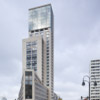
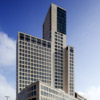
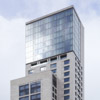
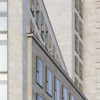
Prof. Christoph Mäckler Architekten / Photographer: Hans-Georg Esch
The main priority behind the Zoofenster development was to give the city and its citizens a certain stability, to fuse disjointed architectural and social structures together again and point the way forward for local building traditions. It is located in a district of “West Berlin” severely marked by war damage and haphazard rebuilding. At the end of the 19th century, then again in the 1920s and finally during the years in which the city was divided, this area functioned as a second or surrogate city. Unsurprisingly, around the Zoo station for underground and local trains, which has become a city landmark, are a few remaining perimeter block developments from the late 19th century as well as striking individual buildings from the 1950s and 1960s plus a few structures representing the béton brut of the late modern movement which together form a disorderly web brutally dissected by roads.
The Zoofenster high-rise ensemble is intended to lend scale to all this, act as a focal point, dominate the scene but at the same time act as mediator. This is why it is designed as a combination of several blocks with different heights. It takes up the diversity of its urban surroundings, focuses these and finishes them off, so to speak. Despite the triangular site, the Zoofenster’s plan form is designed as a rectangle and therefore can continue the essentially orthogonal grid structure of the neighbouring buildings. With a different facade on each side, each one reacting to the particular situation in which it finds itself, this high-rise development is a response to the lack of direction in the urban design of this neighbourhood with its arbitrarily laid out open areas, crossroads and T-junctions, all conflicting with each other.
The complexity of this location and its function in the urban environment are also reflected in the plan layout of the Zoofenster. The medium-rise block is a “public” area, with hotel, restaurants and retailing, which allows the urban space at street level to filter into the building. The sightlines that run together at the Zoofenster site can be read off in the plan layout of the public zones in the hotel, and can be felt everywhere, such as in the triangular form of the glass-roofed atrium or the café facing Breitscheidplatz.

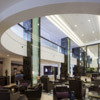
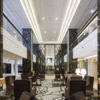
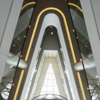
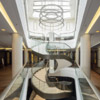
Prof. Christoph Mäckler Architekten / Photographer: Hans-Georg Esch
The medium-rise block, mainly six storeys but eight at the apex of the triangle, matches the eaves heights of the surrounding buildings. Colonnades on all sides continue a Berlin building tradition that can also be seen in the 1950s architecture along the adjoining Joachimsthaler Strasse. So, embedded in the architectural look and feel of its immediate environment, the Zoofenster also offers references to the characteristics and features of the architecture of Berlin as a whole: the window grids of the towers remind the observer of the classical modern movement, which has left behind remarkable examples of the “New Objectivity” in the city. Although seemingly closely related to the famously progressive Berlin of the “Roaring Twenties”, the Zoofenster still shows respect for the impressive grid facades of Egon Eiermann’s Kaiser Wilhelm Memorial Church dating from 1957, which together with the ruins of its neo-romantic predecessor has become one of the city’s principal sights.
Primarily, however, the Zoofenster development reflects the current shift in Berlin’s urban planning strategy towards an individual, unmistakable urban architecture: contrary to the original plans for a glass tower in the prevailing global fashion, the Zoofenster is clad in stone. The Zoofenster facades with their light-coloured limestone achieve their vitality through the restrained play of colours plus the structure of the material itself and the way it has been worked.
The delicate horizontal fluting on the medium-rise block sets it apart from the two towers rising above it, gaining its own accent purely through the changing play of light and shadow on its surfaces. As a continuation of the proverbial “stony Berlin”, the design follows on from the imposing new buildings of recent years that use stone to create bold contours and sculpted surfaces and hence give the city centre in particular its own, distinctive character. Finally, the large area of glazing at the top of the taller tower ensures that the building is visible from afar, especially during the hours of darkness. So, looking back but also looking forward, the Zoofenster aims to become an enduring and convincing sign of both continuity and progress.
The Zoofenster – Building Information
PROJECT DESIGNATION: Zoofenster
LOCATION: Berlin
YEAR OF COMPLETION: 2013
ARCHITECTURE: Prof. Christoph Mäckler Architekten, Frankfurt am Main
INTERIOR ARCHITECTURE: Hotel: INTER ART ETUDES, Paris Offices/shops: Prof. Christoph Mäckler Architekten, Frankfurt am Main
DEVELOPER: Harvest United Enterprises Limited, Abu Dhabi
PROJECT DEVELOPMENT: Swan Operations Limited, Abu Dhabi
PRINCIPAL TENANT: Waldorf Astoria Berlin / Hilton Worldwide
Prof. Christoph Mäckler Architekten
Christoph Mäckler founded his own architectural practice in Frankfurt am Main in 1981, which since his appointment as professor at the University of Dortmund in 1998 has been operating under the name of Prof. Christoph Mäckler Architekten. Christoph Mäckler Architekten pursues a policy of integrating structures into their urban context – apt architecture. In doing so, the built environment, made up of private living spaces and public open spaces, is regarded as “urban architecture”.
Christoph Mäckler’s architecture is distinguished by its reconciliation of tradition and modernity. Prof. Mäckler seeks to reconnect architecture with its premodern roots. The restoration of surface and volume in the facade and the understanding of the building’s material properties play a pivotal role in his work.
Zoofenster in Berlin images / information from Prof. Christoph Mäckler Architekten
Zoofenster Berlin Building design : Prof. Christoph Mäckler Architekten
Location: Breitscheidplatz, Berlin, Germany
Berlin Buildings
Potsdamerplatz Buildings
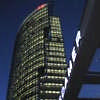
photo © Adrian Welc
Hotel nhow Berlin

photo : Roland Halbe
Berlin Architecture Walking Tours
H10 Berlin Hotel
Design: Architect Jan Kleihues
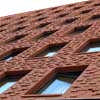
photo : Hagemeister
Kreuzberg Tower in Berlin – a rare building by the late John Hejduk
Comments / photos for the Zoofenster in Berlin Architecture design by Prof. Christoph Mäckler Architekten page welcome.
Website: www.zoofenster-berlin.com

